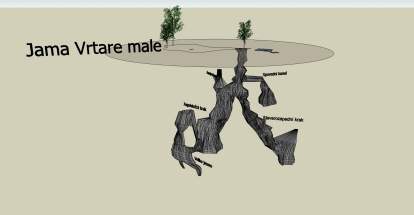
VRTARE MALE CAVE AT DRAMALJ PROVIDED PREVENTATIVE PROTECTION The Vrtare Male Cave at Dramalj, not far from Crikvenica,
is a unique and exceptionally rich site of the fossil remains of animals
from the Pleistocene (Ice Age), and, as a result, it has been provided
preventative protection as a geological and palaeontological natural monument.
In 2005 under the organisation of the Town of Crikvenica and the Crikvenica
Museum, the Institute for Quaternary Paleontology and Geology of the Croatia
Academy of Sciences and Arts (HAZU), together with the Croatian Natural
History Museum, systematically studied the fossil remains. Permissions
for paleontological, as well as speleological and bio-speleological research
were obtained from the Directorate for Nature Protection of the Ministry
of Culture. The narrow entrance to the cave is located in a karst region covered
in sub-Mediterranean forest. The cave has a depth of some 30 metres, at
the bottom of which is a small pool of brackish water. The cave is significant
in terms of bio-speleology, because a subterranean, freshwater cave prawn
(Troglocharis anophthalmus) lives in the pool. This prawn is a stygobiont,
meaning that it lives only in subterranean waters. It is an endemic and
relict species that falls in the category of larger underground animals:
it can be up to 30 millimetres long! The prawn is transparent and blind.
Scattered throughout the entire Dinaric karst, it also has close relatives
in the karst regions of France and Georgia. It feeds on the scarce organic
matter that is found in the mud of the cave or that falls into the mud
from the surface. In addition to a few other sites in the Primorsko-Goranska
County, this interesting eyeless and pigmentless subterranean prawn can
also be found in the underground regions of Ogulin and in Seline at Starigrad-Paklenica.
Among the samples of plankton, an unknown species of the genus Metacalamus
has been recorded and has yet to be fully studied, although there are
indications that this finding could be a new species for science. This
would make the cave the “locus typicus” of the new-described
species. The cave is part of the National Ecological Network, registered under
code HR3000257. The spatial boundaries of the preventative protected area
include the entrance to the Vrtare Male Cave and cover an area of 10 metres
in diameter around the entrance, on cadastral plots number 2684 and 2685
of the Dramalj Cadastre Municipality. For the duration of preventative
protection, lasting a maximum of three years, the provisions of the Nature
Protection Act and other regulations referring to protected natural assets
and protected sites shall be applied to this protected area. |



